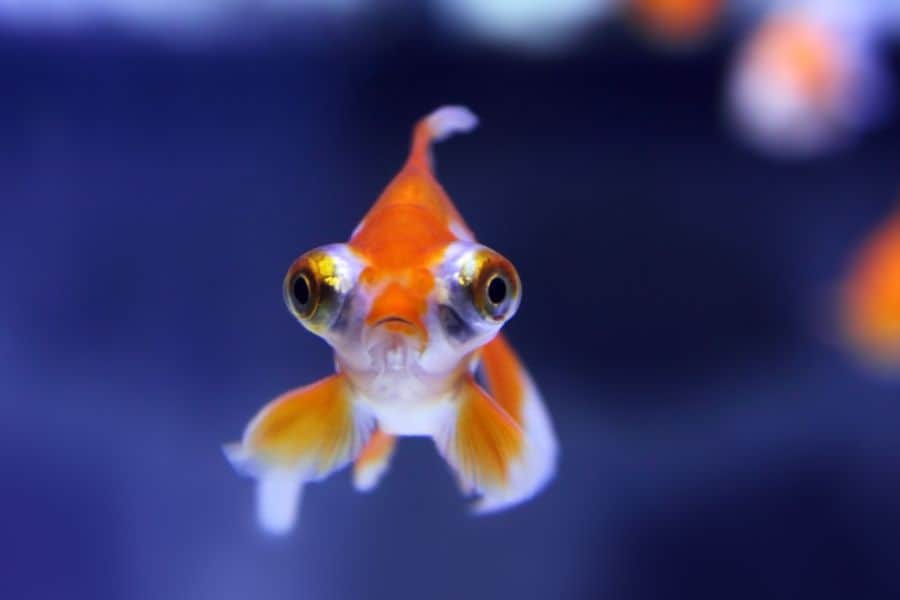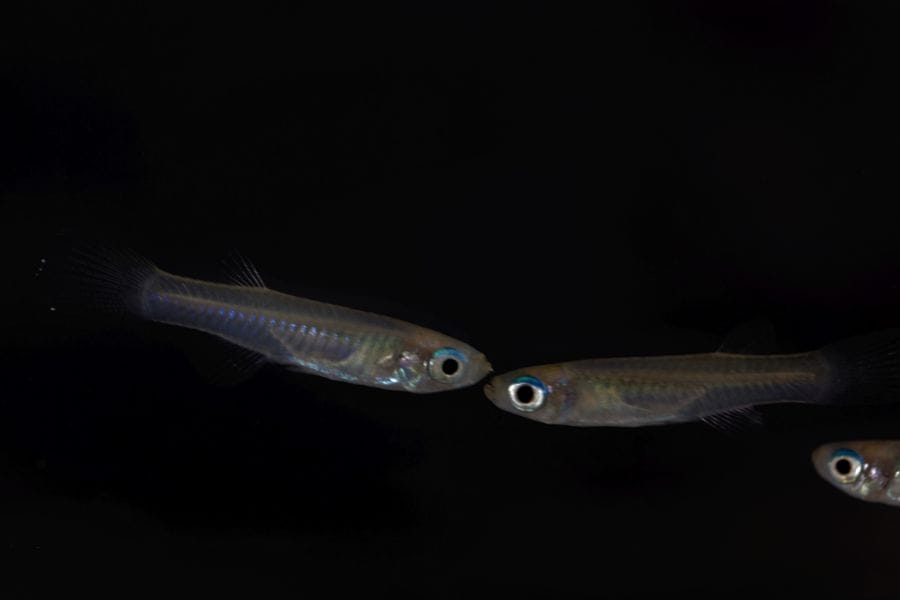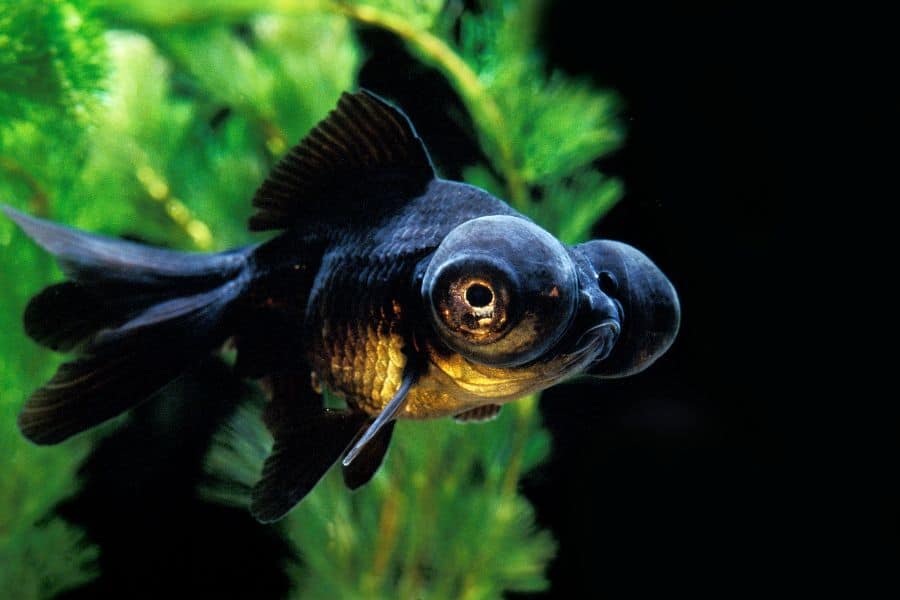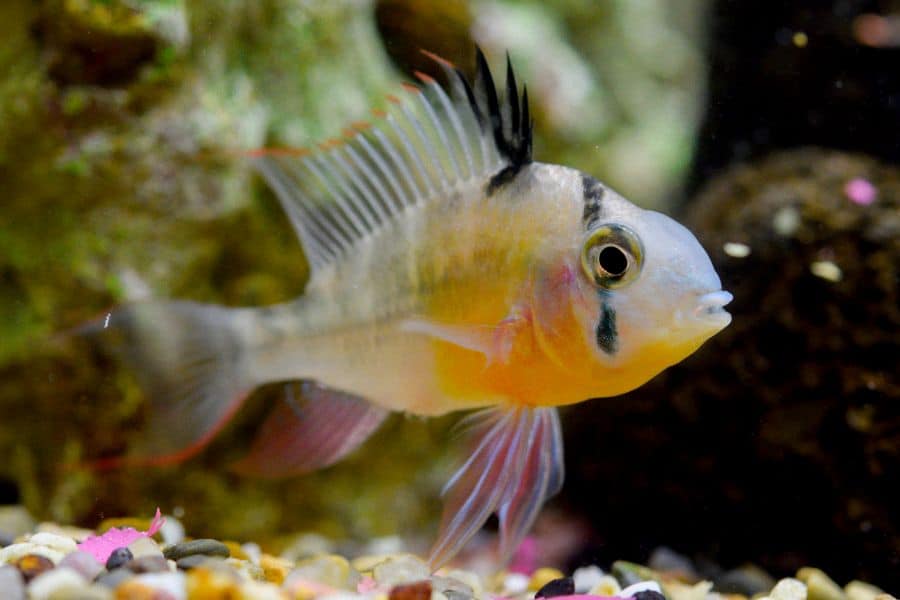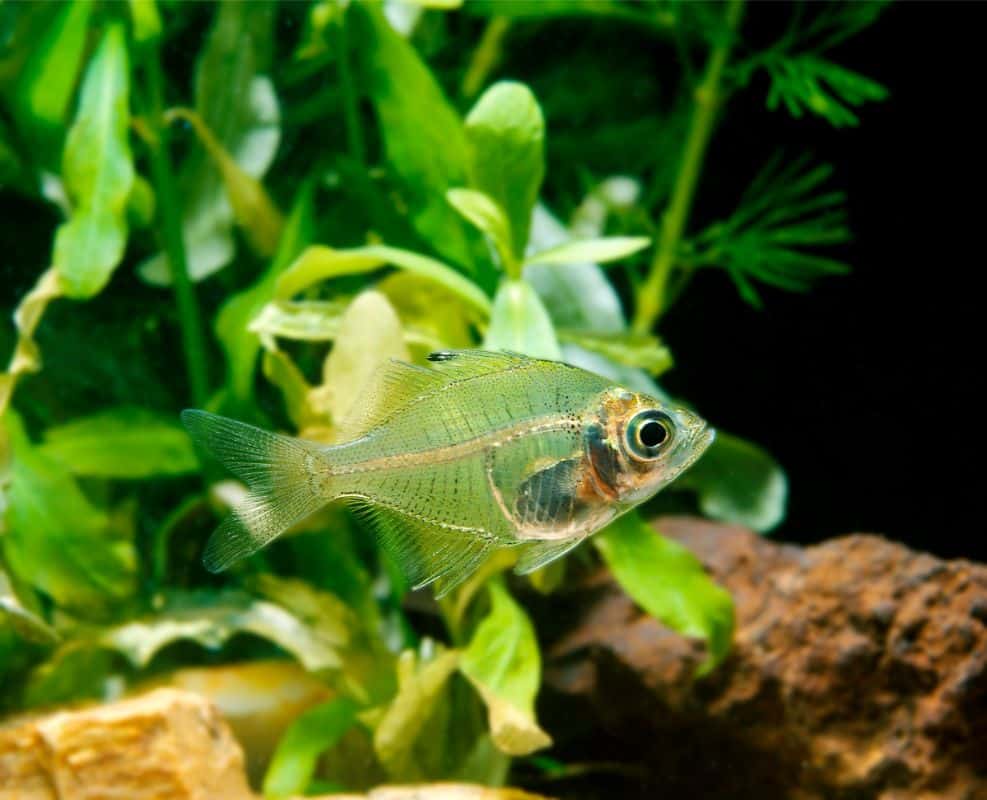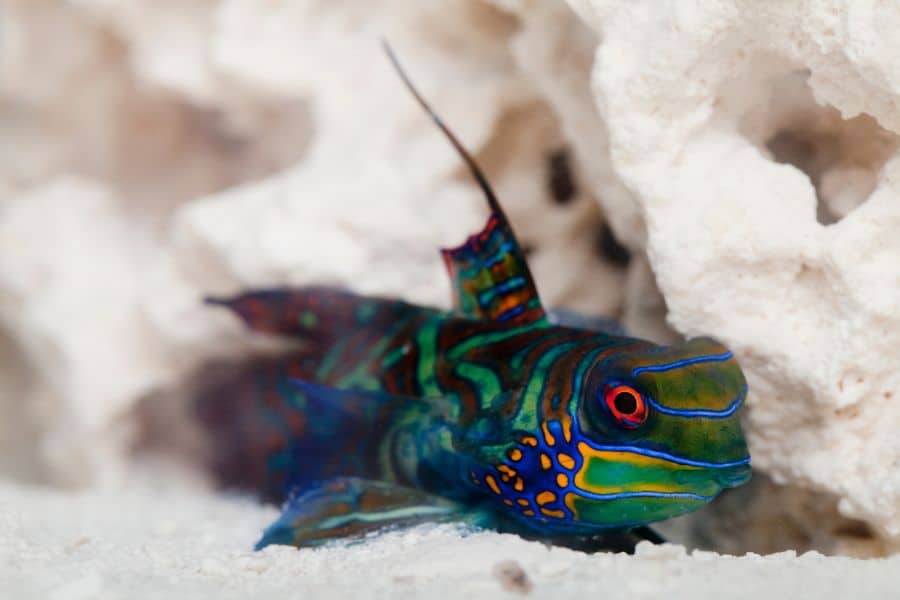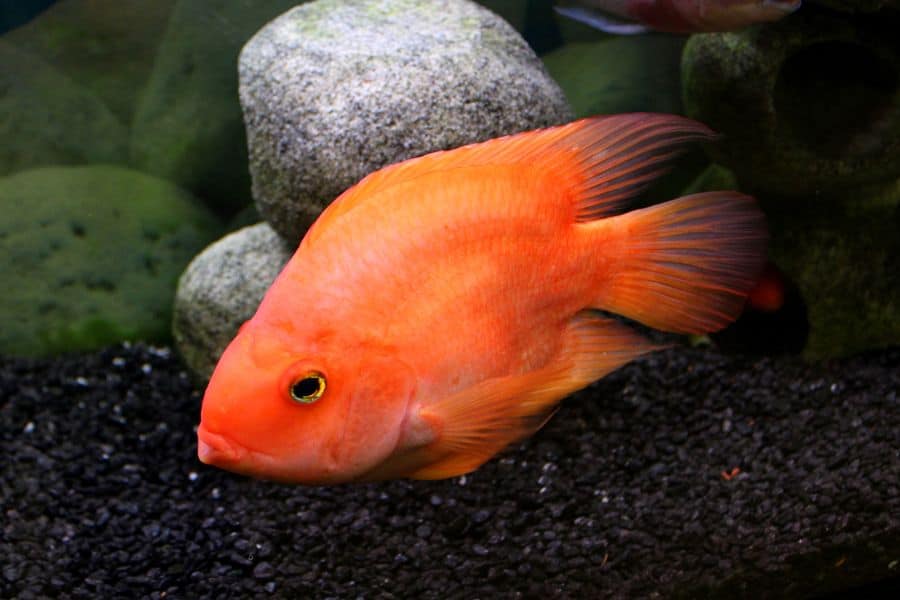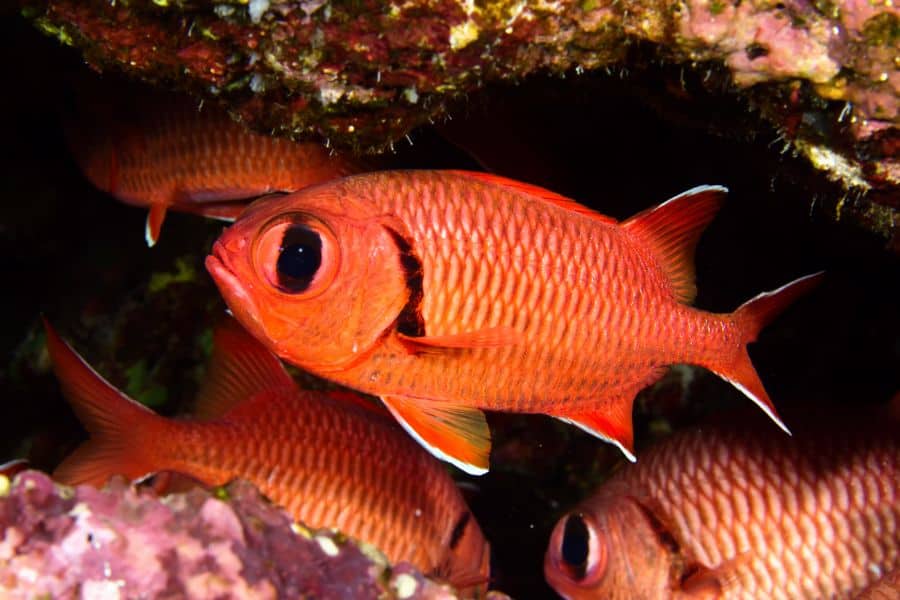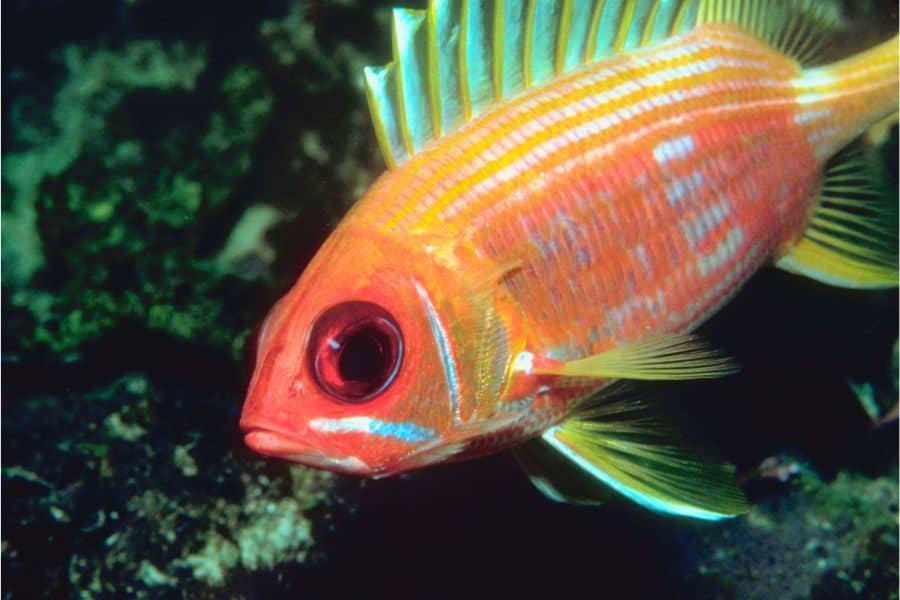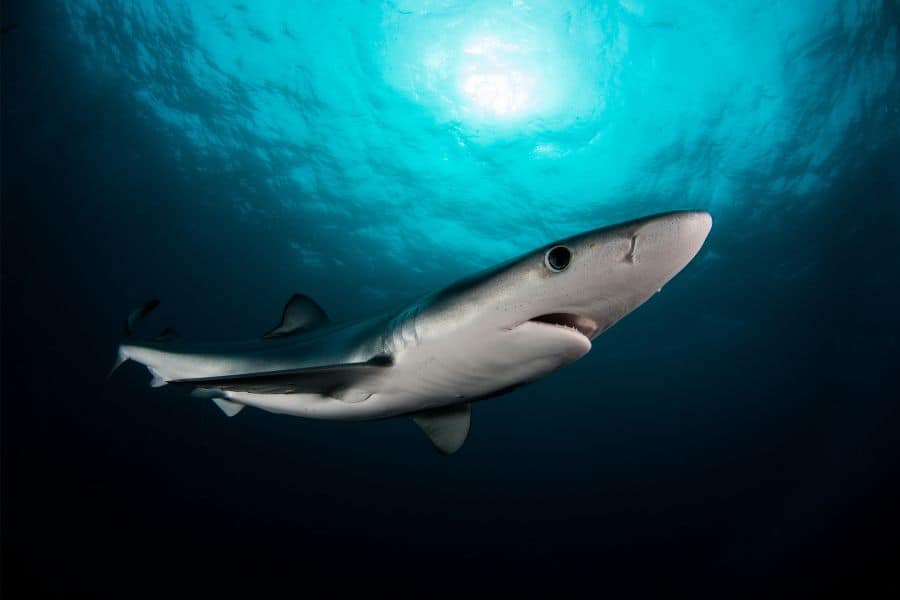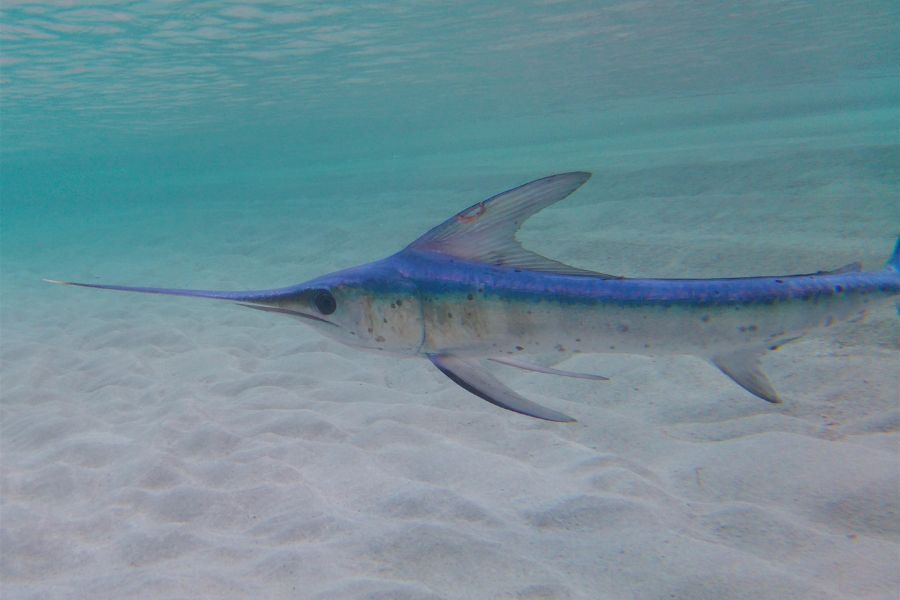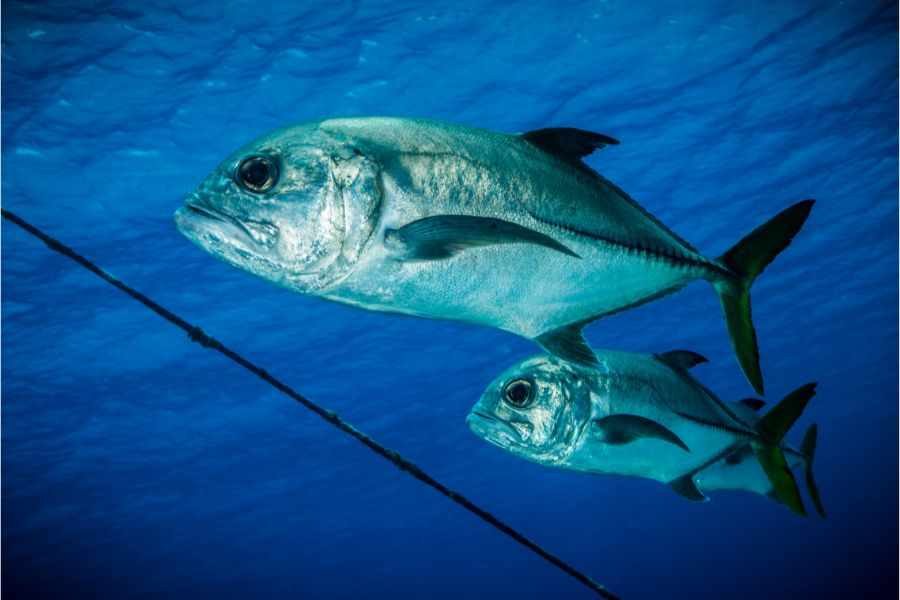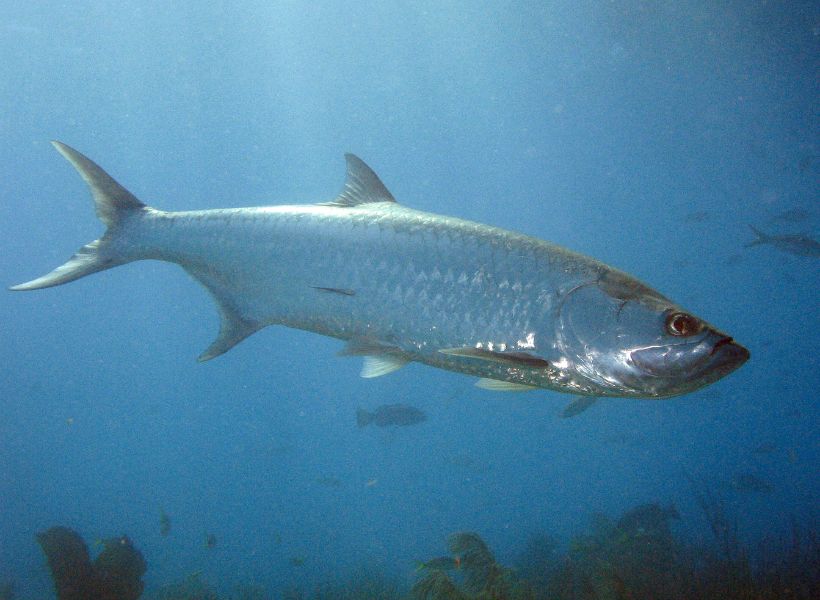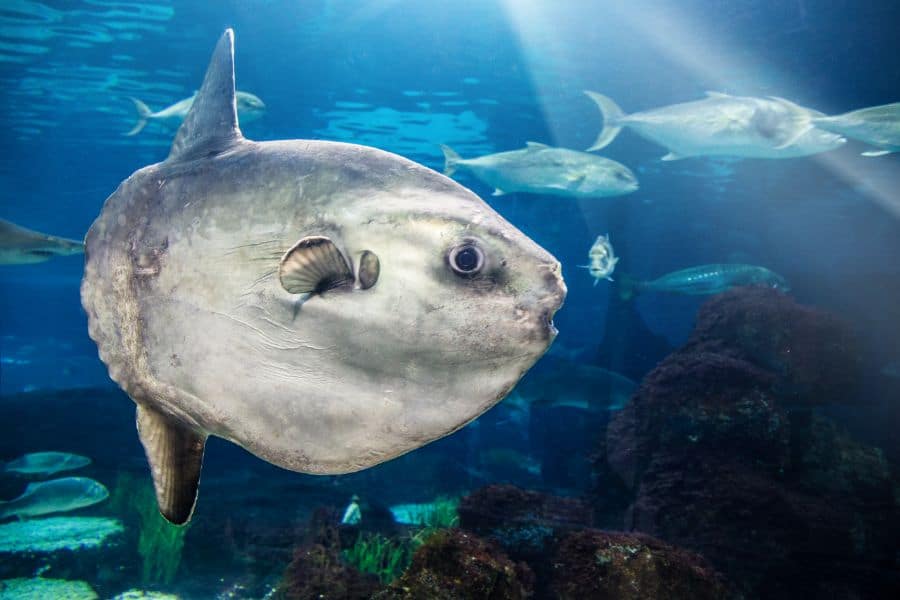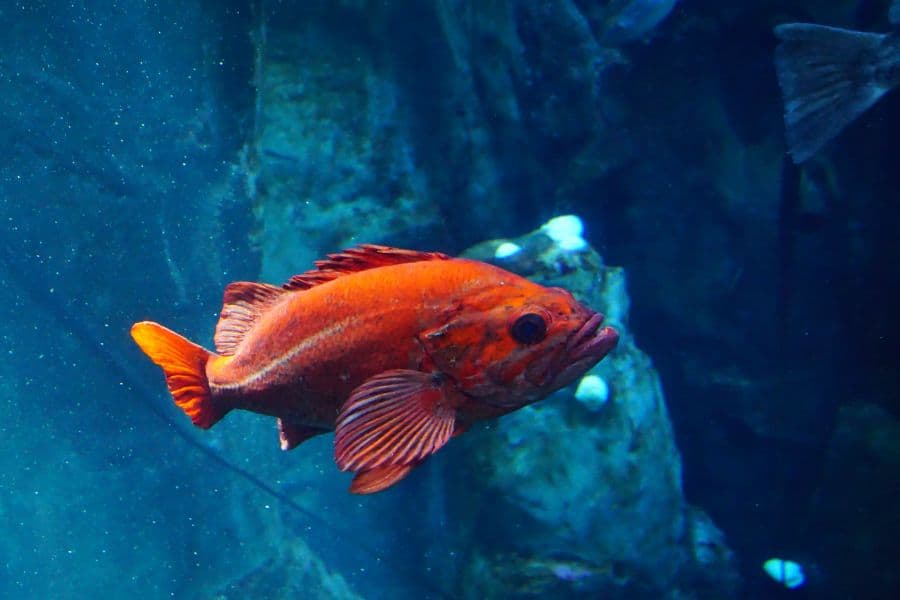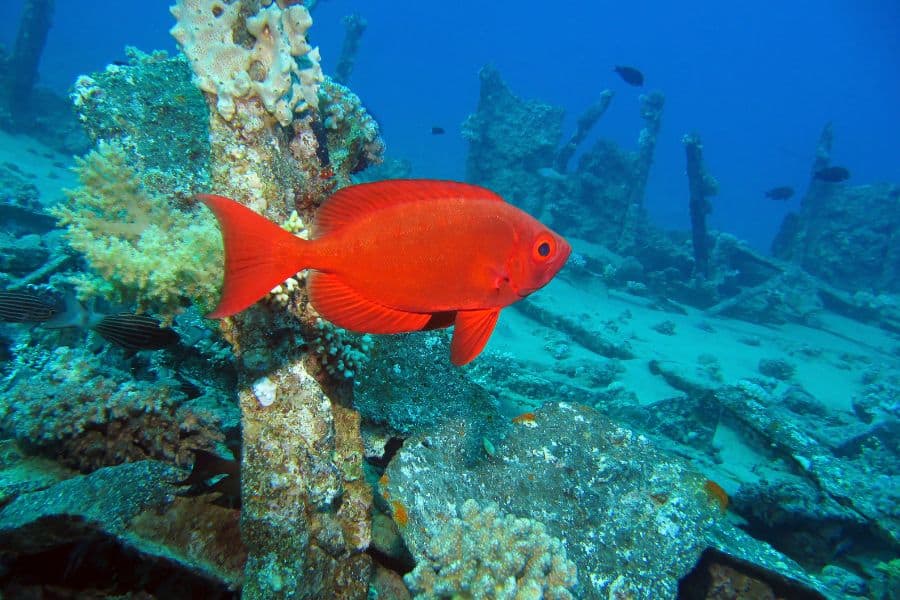For many aquarists, our aquarium setups are our pride and joy.
We want to feature aquatic worlds that arouse people’s interest. And what better way to do this than to display aquarium fish with fascinating features, such as prominent eyes?
In this post, we’ve listed down the best aquarium fishes with big eyes. We guarantee that anything you pick from this list will fascinate your guests so much that they won’t be able to look away!
12 Aquarium Fish With Big Eyes
For the first section, let’s talk about the big-eyed fish that you can keep in your aquarium!
1. Celestial Goldfish
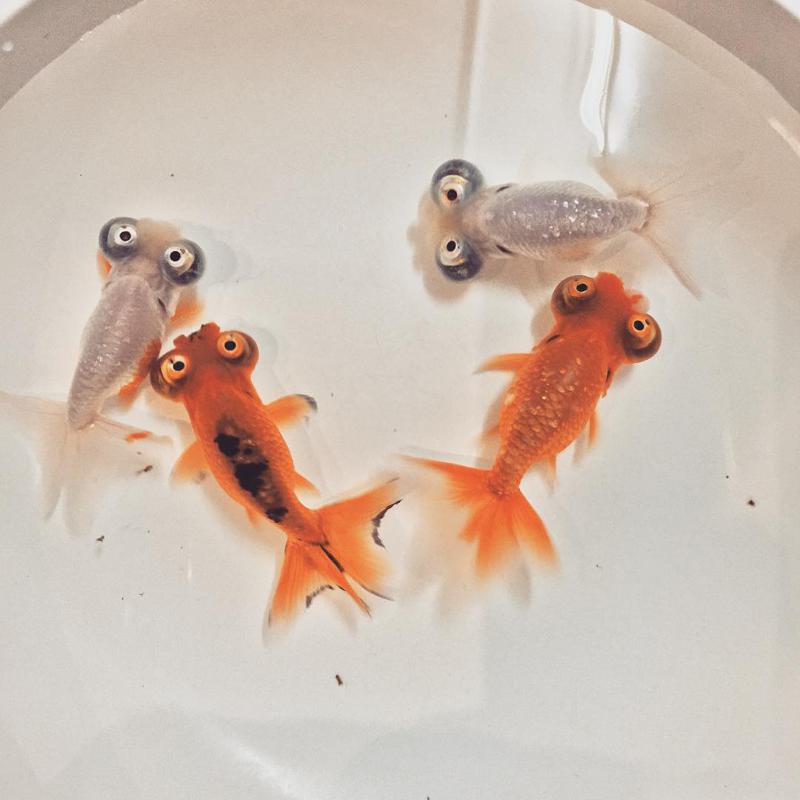
- Scientific name: Carassius auratus
- Water type: Freshwater
- Care level: Intermediate
- Diet: Omnivore
- Size: 5 – 16 inches
- Claim to fame: Unique eye structure
Practically the mascot of the “Fish With Big Eyes Club,” the celestial goldfish boasts magnificently protruding eyes tilted upwards to look towards the heavens, hence the name.
Their main allure is their fantastic eye structure, which is actually a specific mutation in goldfish breeds. Aside from this, though, they also have the regular charms of a goldfish: extremely flowy fins and trademark golden scales.
But while goldfish, in general, may have gained a reputation as beginner aquarium fish, they still need quite a lot of setup and maintenance to keep. Plus, celestial goldfish specifically can be pretty sensitive, as you need to protect their protruding eyes from injury and infection.
If you can keep up with their many needs, you certainly have quite the centerpiece on your hands.
2. Norman’s Lampeye Killifish
- Scientific name: Poropanchax normani
- Water type: Freshwater
- Care level: Beginner
- Diet: Omnivore
- Size:5 – 3 inches
- Claim to fame: Glowing eyelid structure on their prominent eyes
Norman’s Lampeye Killifish is an easily overlooked and little-known jewel for aquarium fishkeepers.
They’re known for having a horizontal crescent “eyelid” at the top of their eye. More interestingly, under the right lighting, these crescents sometimes even seem to shimmer with a bluish hue.
While lampeye killifish don’t have the same kind of protruding eyes as the celestial goldfish, it’s evident that their eyes are also quite prominent on their lithe, elongated, and vividly colored bodies.
These fish are known to jump, so a tightly fitting lid is essential. They’re also quite skittish, so they’re best kept in species-only tanks or with similarly peaceful inhabitants.
Other than that, the lampeye killifish is relatively hardy and easy to care for, making them an excellent choice for those looking to have subtle yet captivating species to feature.
3. Amazon Pufferfish
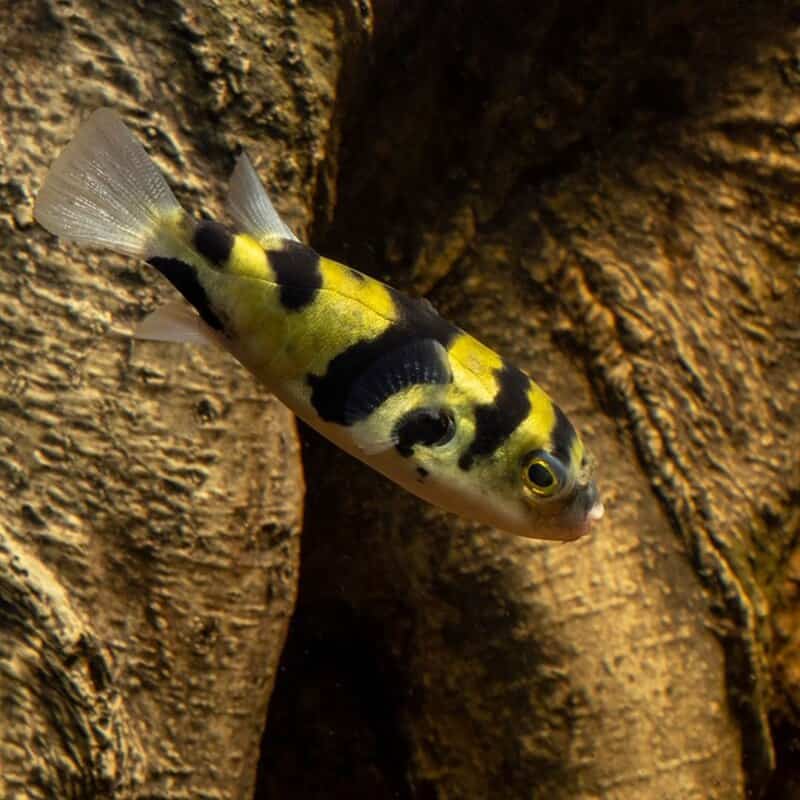
- Scientific name: Colomesus asellus
- Water type: Freshwater
- Care level: Intermediate
- Diet: Carnivorous
- Size: 4 inches
- Claim to fame: Interesting appearance and personality
The Amazon Pufferfish is renowned for its fascinating appearance and personality, although it also has pretty prominent and large eyes for its body size.
The Amazon Puffer has a distinctively boxy head, banded patterns on its body, and large pectoral fins. They’re also quite intelligent – widely known to interact with their human caretakers.
That said, you do need to provide them with a well-maintained tank with ample swimming space and hiding spots. They’re relatively small, but they do like moving around.
Also, since they’re predatory fish, they can easily prey on their tankmates. It’s best to keep them alone or in a single-species tank with at least five other Amazon puffers.
While the Amazon Pufferfish’s unique appearance can be enticing, their specific care needs requirements make them better for intermediate aquarists willing to put in the effort.
4. Telescope Goldfish
- Scientific name: Carassius auratus
- Water type: Freshwater
- Care level: Intermediate
- Diet: Omnivore
- Size: 4 to 10 inches
- Claim to fame: Interesting eye shape
The Telescope Goldfish is recognized for its enormous and protruding eyes. Combined with its round body and vibrant colors, this fish exhibits a charmingly odd appearance favored by many fishkeepers around the globe.
It has rather protruded eyes similar to the celestial goldfish. However, the telescope goldfish distinguishes itself because its eyes are pointed sidewards rather than upwards.
They’re great for intermediate fishkeepers who know the rigorous care requirements of goldfish, such as their dietary, filtration, and water parameter requirements.
If you know how to care for them properly, they’re a visual spectacle.
5. Bolivian Ram Cichlid
- Scientific name: Mikrogeophagus altispinosus
- Water type: Freshwater
- Care level: Beginner
- Diet: Omnivore
- Size:5 inches
- Claim to fame: Interesting appearance and hardiness
This is another fish that’s not quite known for its large eyes, but once you look at them, you notice that their peepers tend to be larger in proportion to their bodies compared to other species.
This fish species sports a silver body with some other colors here and there. Their main appeal is the interesting shape of their fins.
Bolivian Rams are known for their charming personalities. You will often see them engaging with their surroundings and tank mates and are thus well-suited for community tanks with similarly peaceful species.
They like plenty of hiding spots in their environment. They’re also pretty hardy and don’t require much special care.
If you want a beautiful, low-maintenance, friendly beginner fish with big eyes, go for Bolivian rams.
6. Glassfish
- Scientific name: Parambassis ranga
- Water type: Freshwater
- Care level: Beginner
- Diet: Carnivorous
- Size: 3 inches
- Claim to fame: Transparent body
Glassfish is another hidden gem that could be more popular in the hobby, but it definitely should be. They have relatively large eyes in proportion to their bodies, although not the protruding ones that the goldfish varieties have.
Their main claim to fame is their transparent bodies, lending them a uniquely ethereal effect in the right aquarium.
While its appearance may be delicate, the glassfish is a relatively hardy and adaptable community fish, making it great for beginners.
Glassfish are carnivorous and thrive on a protein-rich diet. Ensure they have a consistent supply of high-quality freeze-dried or live food if you keep them.
With proper care and attention to their environment, you can feature this excellent fish’s unique look and large eyes.
7. Bubble Eye Goldfish
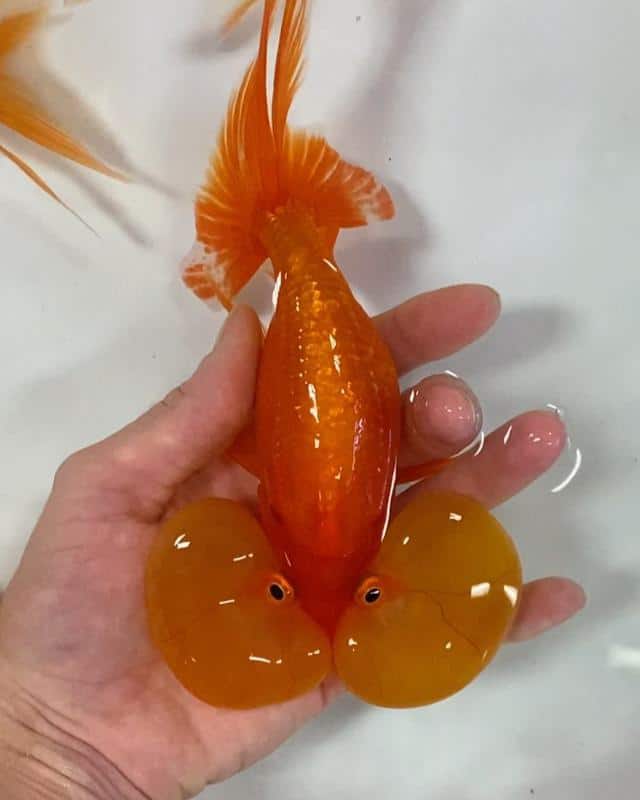
- Scientific name: Carassius auratus
- Water type: Freshwater
- Care level: Advanced
- Diet: Omnivore
- Size: 6 inches
- Claim to fame: Large air bubble under their eyes
It’s easy to see what put this species on this list. With their large, fluid-filled eye tissue that balloons to improbable proportions, there’s nothing quite like them in the aquarium world.
While its striking appearance sets it apart, the Bubble Eye Goldfish requires careful attention due to its unique needs.
Their delicate sacs are susceptible to damage, so you need a well-maintained and gentle environment with no other, or at least very peaceful, occupants. These goldfish should be kept in aquariums without anything that can potentially harm them.
They also need extra care when feeding, as they are slow-moving fish with lousy eyesight, which might cause them to lose out on feeding opportunities.
Due to their delicateness, this species is more suited for experienced keepers who can provide the meticulous care it needs. But if you can step up to the challenge, they’re quite a captivating and impressive addition to any setup.
8. Mandarin Dragonet
- Scientific name: Pterosynchiropus splendidus
- Water type: Saltwater
- Care level: Advanced
- Diet: Carnivore
- Size: 3 inches long
- Claim to fame: Dragon-like shape and hypnotic patterns
The Mandarin Dragonet, also known as the Mandarin fish or Mandarin goby, is an exquisite saltwater fish that boasts luxurious fins, vibrant colors, and intricate patterns.
This fish is often considered one of the most beautiful in the aquarium trade because of its otherworldly appearance.
While its main feature isn’t their eyes, you do notice their eyeballs sitting quite prominently on the top of their head, like little balls mounted on their front – the reason why they made it to the list.
While its appearance is stunning, keeping this tiny dragon is not for the faint of heart. They have stringent requirements that even advanced aquarists need help to provide, such as their dietary needs.
Aside from their strict care and dietary requirements, these fishes are peaceful and would do great in any community reef aquarium.
9. Parrotfish Cichlid
- Scientific name: N/A
- Water type: Freshwater
- Care level: Beginner
- Diet: Omnivore
- Size: 8 inches
- Claim to fame: Distinctive appearance and color
So named for their resemblance to the famous saltwater parrotfish, the parrotfish cichlid is another species with rather prominent eyes compared to other species.
They have a distinct triangular face and intensely bright coloration, making them stand out from other cichlid species. But more than their appearance, the parrotfish cichlid also has a rather exciting background – because practically nobody knows precisely what they are.
While thought to be a hybrid of several different cichlids, no one is sure. The most popular guesses involve the Midas cichlid, redhead cichlid, and red devil cichlid.
Regardless of their origins, this species is widespread in the hobby because of their attractive appearance and ease of care, although you’ll need large aquariums to house them adequately.
10. African Butterfly Fish
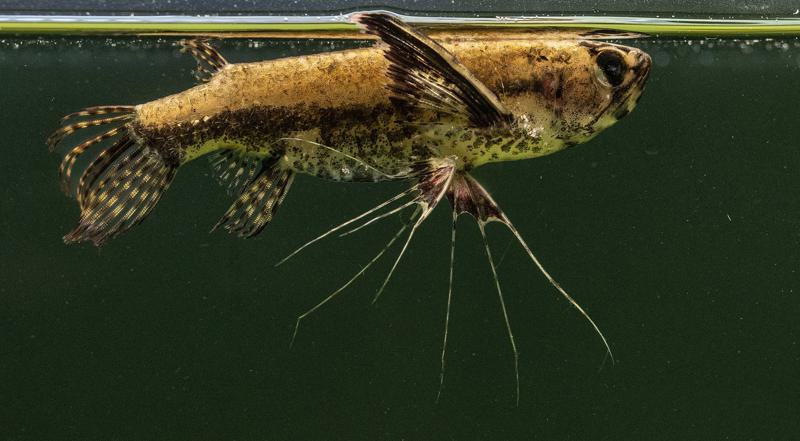
- Scientific name: Pantodon buchholzi
- Water type: Freshwater
- Care level: Advanced
- Diet: Carnivorous
- Size: 5 inches
- Claim to fame: Interesting shape and hunting behavior
Also called the freshwater butterflyfish, this is one of the most unique freshwater aquarium fish you will encounter.
Their entire body is designed specifically for hunting on the water’s surface.
This means they have large, prominent eyes that occupy almost a quarter of their heads, upturned mouths, and powerful horizontally oriented pectoral fins that allow them to jump out of the water to hunt.
Despite their cool appearance, only a few aquarists own them as pets because they have specific setup requirements and feeding needs that can be difficult for the average person to adhere to.
But if you can rise to the challenge of keeping this unique hunting fish, you’ll definitely be one of the coolest aquarium keepers on the block.
11. Big Eye Black Bar Soldierfish
- Scientific name: Myripristis sp.
- Water type: Saltwater
- Care level: Beginner
- Diet: Carnivore
- Size: 8 inches
- Claim to fame: Big natural eyes and intense color
Also known as black bar soldierfish, this sleek saltwater marvel cuts an impressive figure. With their large eyes, arrayed fins, and intense red coloration, this species will undoubtedly catch the eye of anyone coming over for a visit.
This carnivorous species is relatively easy to care for if you have the proper setup.
This species can grow pretty big, so you’ll need plenty of volume. They are also carnivorous and do well with plenty of living rocks around them.
Lastly, big-eye soldierfish are nocturnal, which is why they have large eyes. Hunting at night means they need to be able to see their surroundings better, and their big eyes allow them to do that.
12. Squirrelfish
- Scientific name: Holocentridae
- Water type: Saltwater
- Care level: Intermediate
- Diet: Carnivore
- Size: 7 – 24 inches
- Claim to fame: Prominent eyes
The squirrelfish is another saltwater aquarium fish with prominent eyes because of its nocturnal nature. The term is actually used on the whole family of this fish, which aquarists keep as different pets.
Despite their many different species, though, squirrelfish uniformly feature eyes that occupy most of their heads. This is because they hunt at night and need lots of light to reflect on their eyes to seize their prey.
The squirrelfish has many different patterns and colorations, with varying sizes and characteristics. If you want to feature squirrelfish in your aquarium, you will have lots to choose from.
10 Most Popular Fish With Big Eyes in the Wild
Of course, big-eyed fish aren’t just found in the aquarium – they look even more impressive out there in the wild.
Interested in seeing some of them? Here are ten of the most popular big-eyed fish that you can’t keep in an aquarium!
1. Blue Shark
The blue shark (Prionace glauca) is a sleek-looking marine creature that can be found in the cool areas of both temperate and tropical oceans. They’re harmless to humans, despite their aggressive look.
Just as its name suggests, the blue shark is named for its rather attractive deep blue color, which contrasts beautifully with its silver sides and white belly.
They have rather prominent eyes, which they use to hunt their prey. Since blue sharks prefer cold areas, they tend to swim in darker regions of the ocean, and their eyes maximize the scant amount of light that exists in their preferred areas.
2. Bigeye Thresher Shark
The bigeye thresher (Alopias spp.) is another fascinating species of shark with exceptionally large eyes, which help it see in low-light conditions in the deep ocean.
Like many other sharks, they have the typical shark coloration, with varying shades of blue, grey, purple, and brown.
Aside from their eyes, they’re also known for having extremely long tails that measure almost as long as their bodies, giving them incredible speeds when chasing prey.
This species hunts in the deep during the day and comes closer to the surface at night. They make full use of their large eyes to hunt for prey.
3. Barracuda
The barracuda (Sphyraena) is a type of predatory fish that’s infamous for being quite aggressive.
While this species is certainly a ferocious hunter, they’re typically afraid of humans. There have been incidents of barracudas attacking swimmers or divers, but scientists theorize that they only happened because these fish mistook humans for prey.
Barracudas also have great big eyes, which, along with their elongated body and powerful tail, are used for hunting their food. They have extremely fine-tuned eyesight that can spot prey from far away.
4. Swordfish
Swordfish (Xiphias gladius) have a streamlined body with a deep blue color and a silver belly. They can be found in warm oceanic waters worldwide, from the surface down to depths of around 2,000 feet.
True to their name, their most distinguishing feature is their long, flat bill, which resembles a sword and can be longer than the fish’s body.
Swordfish are predators, and yes – they do use their long sword-like bills for hunting. That said, research has found that they don’t impale fish with them. Instead, they slash at schools of fish and injure their targets for an easier catch.
Being a mighty predator, swordfish also rely on their large eyes to locate their prey and hunt them down in low-light conditions.
5. Bigeye Tuna
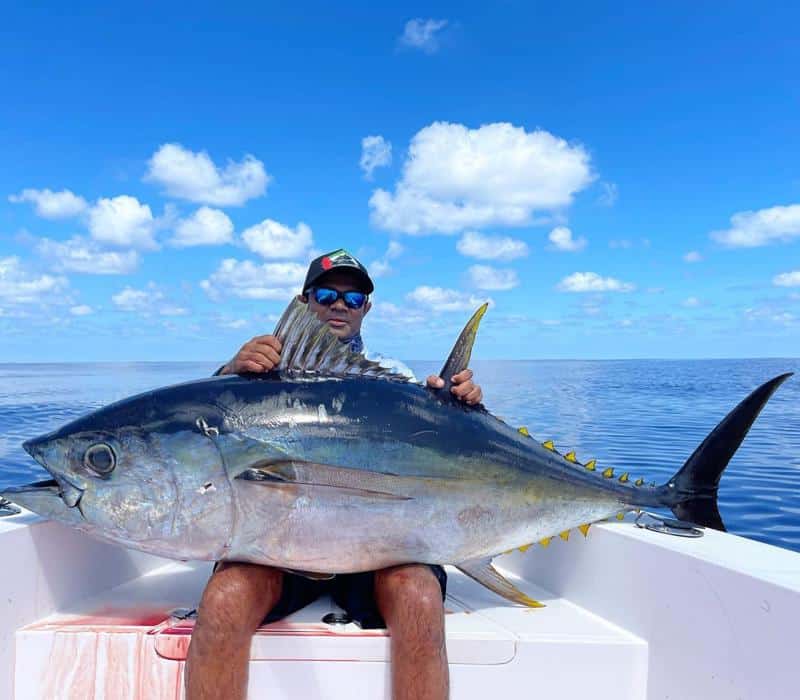
Bigeye tuna (Thunnus obesus) is a highly sought-after species of tuna known for its large size, deep red flesh, and culinary popularity. As their name suggests, they also have great eyes that really stand out.
This species has a streamlined, torpedo-shaped body with dark blue-black coloring on its upper body and a silvery-white belly.
Bigeye tuna can grow to impressive sizes, with adults typically reaching lengths of 8.2 feet and weighing between 400 pounds.
Considered to be one of the best-tasting tuna species, they’re prized for their delicious, fatty flesh, which is often used in sushi and sashimi. Unfortunately, though, they’re a victim of overfishing, so conservationists are constantly monitoring their population.
6. Horse-Eye Jack
Also known as the big-eye jack or the horse-eye trevally, horse-eye jacks (Caranx latus) have an elongated, somewhat flattened body with a reflective silvery coloration.
Even among other fishes on this list, the horse-eye jack sports some truly marvelous large, oval-shaped eyes that give them their name. They can grow to a substantial size, with adult horse-eye jacks typically ranging from 100 cm, and can weigh about 13 kilos.
Horse-eye jacks are popular targets for recreational anglers due to their size and fighting ability. They provide a challenging and exciting catch. They’re commonly found in warm, tropical, and subtropical waters of the Atlantic Ocean.
7. Tarpon
The tarpon (Megalops) is a large, iconic fish species found in warm coastal waters and estuaries. They’re known for their distinctive appearance – a large, elongated body covered in large scales. They have a shiny, silvery coloration and a large, upward-facing mouth.
They’re purely carnivorous fish, so their large eyes are used for hunting smaller prey.
Tarpon are highly prized as a game fish and are a popular target for recreational anglers. Catching a tarpon is considered a significant achievement due to its size, strength, and fighting ability. They’re also among the largest fish species that anglers commonly pursue.
8. Ocean Sunfish
Popularly known as the giant ocean sunfish (Mola Mola), this marvel of the ocean is a bizarre mystery in many ways.
It has a unique and almost unreal appearance, with an extremely flattened, oval-shaped body that can reach immense sizes and weights, with some individuals weighing thousands of kilograms. Their eyes may not look as big as the others on this list, but they’re comical compared to the rest of their body.
Because of their unusual shape and size, they can’t swim very well. They often end up floating on their sides on the surface of the ocean, which is how they got their common name.
Despite their odd appearance, giant ocean sunfish play a role in marine ecosystems by controlling jellyfish populations, which can become problematic when their numbers surge.
9. Rockfish
Rockfish (Sebastes spp.) are a family of hard, bony fish that are known to populate our many different oceans, particularly in the Pacific and Atlantic oceans.
True to their name, these fish can get mistaken as rocks – their choice of camouflage against predators as well as their way to prey on unsuspecting fish who wander into their territory.
Interestingly, rockfish have large, circular eyes compared to their relatively tiny mouths. They use these eyes to hunt as deep as 9,000 feet under the sea.
10. Bigeye Fish
No list of big-eyed fish is complete without the Priacanthidae family of deep-sea fish. This family comprises 18 species of fish, all of which are ray-finned and big-eyed. Most of them live in the Pacific and Indian Oceans, with a few surviving in the neighboring Atlantic Ocean.
They’re carnivorous, nocturnal fish, which means they need to hunt for prey in the darkness of the deep. In these areas, the light is very limited, and opportunities to catch prey are scarce. This is where their large eyes come in handy.
Read More: Popular Fish With Big Lips
FAQs
Why Do Some Fish Have Big Eyes?
It depends on the fish species. If they have naturally big eyes, it might be because they need to rely a lot on their eyesight to hunt, like the nocturnal squirrelfish and big-eye soldierfish on the list.
However, some species are selectively bred to have larger eyes than average. One example is the bubble eye goldfish, valued for its unnatural eye bubbles.
Is It Normal for My Fish to Have Big Eyes?
If your fish species didn’t have big eyes before, they might suffer from popeye disease, also called exophthalmia. It’s when fluid builds up in the eyes of your fish, resulting in swelling. When this happens, urgent professional care is required to save your fish.
Is Having Big Eyes Healthy for My Fish?
If your fish don’t have big eyes, they might suffer from Popeye disease, which needs expert attention. But if your fish has naturally big eyes, they’re pretty healthy as long as they aren’t injured.
Conclusion
Fish with a specific prominent feature is one of the ways that you can distinguish yourself from the crowd and feature unique pets in your aquarium. With this list, we’ve shortened your selection process by discussing the most popular aquarium fish with big eyes in detail.
Although we went into some detail about each fish, there still needs to be a comprehensive discussion of their needs.
If you plan on raising fish with big eyes–especially those requiring advanced experience–it’s essential to do your due diligence and ensure you can deliver their needs.
